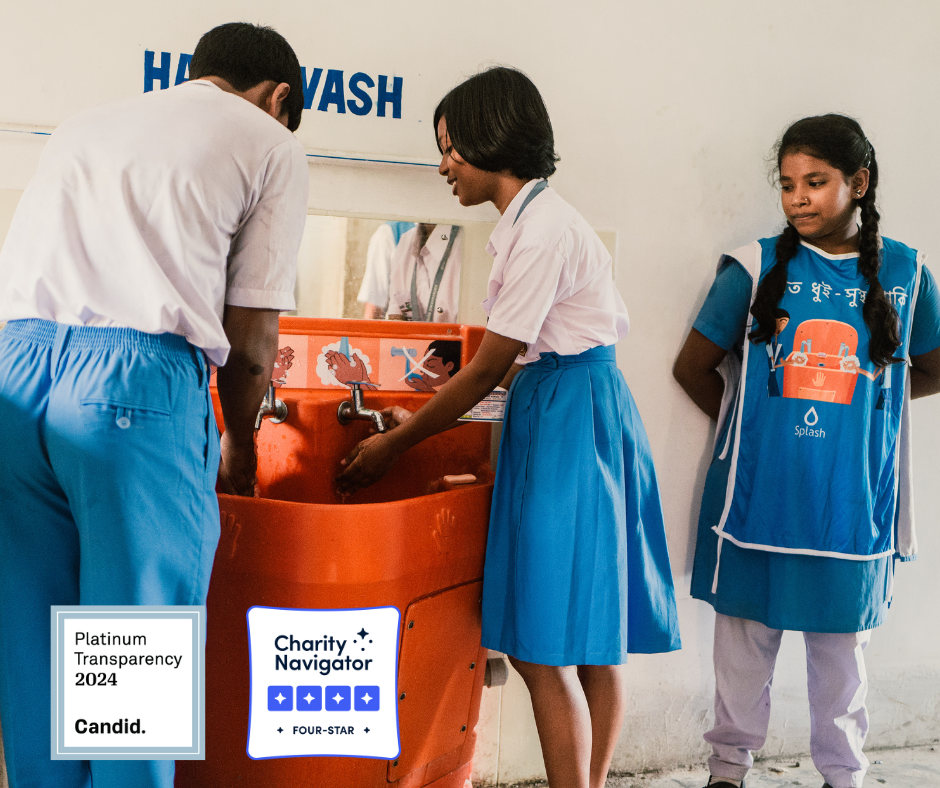Articles and information about Splash and the work we do.

March 29, 2024
Navigating Charity Rankings

We're thrilled to announce that Splash has once again been recognized for our commitment to transparency, accountability, and impact. We've achieved a four-star rating from Charity Navigator, earned the Platinum Seal of Transparency through Candid, and attained accredited charity status with the BBB Wise Giving Alliance (give.org).
These organizations play a crucial role in guiding prospective donors toward responsible giving by evaluating nonprofits' accountability and transparency, and to some extent, their impact. Yet, there are both benefits and drawbacks of charity rankings, and they are not the only tool to use when evaluating whether a particular nonprofit is the right match for your donation.
Benefits of Charity Rankings
- Reaching New Audiences: Charity rankings provide nonprofits with exposure to audiences they might not otherwise reach, potentially attracting more donations and support. Sites allow users to search by issue and find worthy organizations they may not have otherwise heard about.
- Guiding Donors: For donors, charity rankings offer valuable insights into organizations' trustworthiness and effectiveness, helping them make informed giving decisions and avoid potential scams, especially in the aftermath of disasters.
- Enhancing Transparency: By evaluating financial health, governance practices, and transparency in reporting, charity watchdogs can facilitate transparency and accountability within the nonprofit sector, fostering trust between nonprofits and their stakeholders.
- Setting Standards for Performance: Charity rankings establish benchmarks for nonprofit performance, enabling organizations to gauge their own progress, identify areas for improvement, and enhance their credibility and effectiveness.
Drawbacks of Charity Rankings
- Infrequent Updates: Charity rankings are typically updated annually or biennially, which means they may not always reflect the most recent developments at organizations.
- Limited Scope of Measurement: Rankings often rely heavily on quantitative data, potentially overlooking the qualitative aspects of nonprofits' work and leading to a mismatch between actual effectiveness and rankings.
- Incompatibility with Certain Types of Work: Some rankings may not adequately capture the effectiveness of nonprofits engaged in advocacy, research, or other types of work where impact is not easily quantifiable.
- Costs Associated with Ratings: While many charity rating websites provide free evaluations, some offer additional services for a fee, potentially creating barriers for smaller nonprofits with limited resources.
Considerations to Keep in Mind
- The Overhead Myth: The overhead myth refers to the misconception that a nonprofit's effectiveness can be accurately gauged solely by its overhead ratio—the percentage of its budget that goes toward administrative and fundraising expenses as opposed to programmatic activities. This notion suggests that nonprofits with lower overhead ratios are more efficient and effective, while those with higher ratios are inefficient or mismanaging funds.
In more recent years, this damaging myth has been falling out of favor among people in the nonprofit sector and by charity watchdogs as well (see this letter co-authored by Guidestar (now Candid), Charity Navigator, and the BBB). By shifting the focus from overhead ratios to outcomes and mission alignment, we can better support nonprofits in achieving their goals and making meaningful contributions to society.
- Challenges Faced by Small and POC-Led Organizations: Smaller nonprofits face challenges in achieving high rankings from charity watchdogs due to resource limitations, scale of operations, investment constraints, and capacity for compliance and governance. Limited funding restricts their ability to allocate resources for administrative tasks, such as financial reporting and compliance measures, which are key criteria for evaluation. Smaller nonprofits may also lack the scale to demonstrate significant impact or efficiency compared to larger organizations.
Organizations led by people of color (POC) encounter additional hurdles. Charity ranking sites may use evaluation criteria that do not fully account for the challenges faced by marginalized communities, leading to a lack of recognition for the unique strengths and contributions of POC-led organizations. They may also lack understanding of diversity and inclusion within the nonprofit sector, further exacerbating the disparities. Additionally, POC-led organizations often encounter systemic barriers to accessing funding and resources, hindering their ability to meet the criteria set by charity watchdogs and invest in compliance, reporting, and evaluation measures.
Bottom Line
While charity rankings serve as valuable tools for evaluating nonprofits, they may not always tell the full story. When considering donating to a nonprofit, explore its ranking but also conduct your own assessment based on factors such as its financial reports, legal status, impact, values, and alignment with your interests.
At the end of the day, what matters most is supporting organizations whose missions resonate with you and whose work you believe in. By combining charity rankings with your own research and considerations, you can make informed decisions that maximize your impact as a donor.

